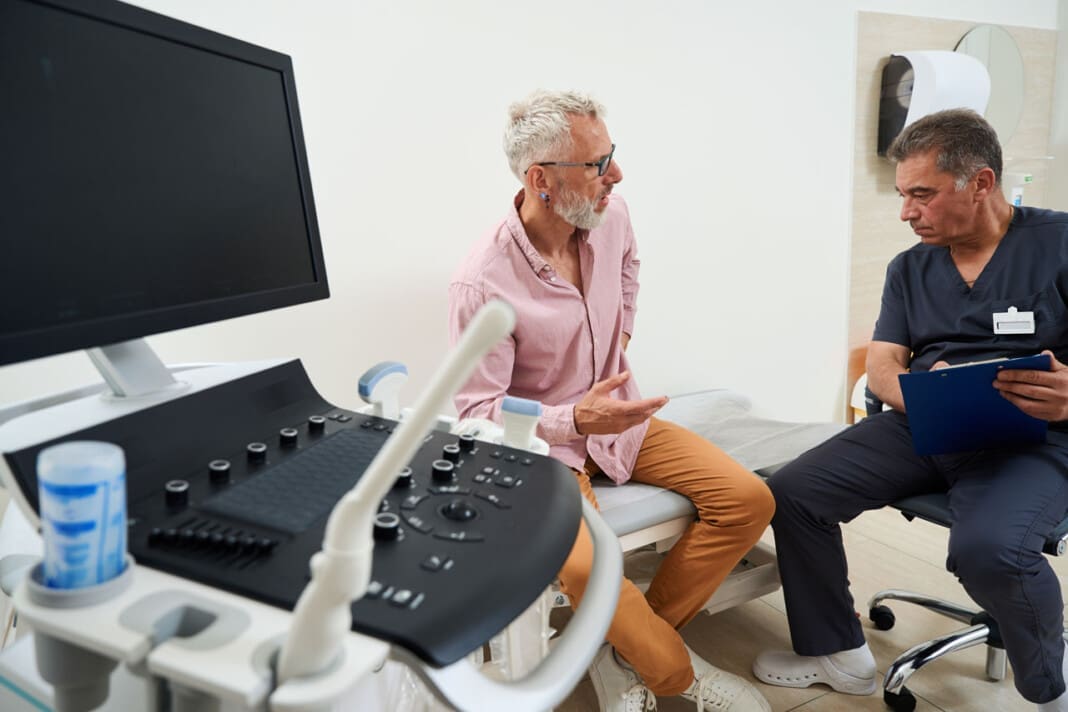“For individuals dealing with chronic pain, can undergoing a nerve block procedure help alleviate and manage symptoms?”

Table of Contents
Nerve Blocks
A nerve block is a procedure done to interrupt/block pain signals due to nerve dysfunction or injury. They can be used for diagnostic or treatment purposes, and their effects can be short or long-term, depending on the type being used.
- A temporary nerve block may involve the application or injection that stops pain signals from transmitting for a short time.
- For example, in pregnancy, an epidural injection can be used during labor and delivery.
- Permanent nerve blocks involve cutting/severing or removing certain parts of a nerve to stop pain signals.
- These are used in cases with severe injuries or other chronic pain conditions that have not improved with other treatment approaches.
Treatment Usage
When healthcare providers diagnose a chronic pain condition caused by nerve injury or dysfunction, they may use a nerve block to locate the area generating pain signals. They may perform electromyography and/or a nerve conduction velocity/NCV test to pinpoint the cause of chronic nerve pain. Nerve blocks can also treat chronic neuropathic pain, such as pain caused by nerve damage or compression. Nerve blocks are regularly used to treat back and neck pain caused by herniated discs or spinal stenosis. (Johns Hopkins Medicine. 2024)
Types
Three types include:
- Local
- Neurolytic
- Surgical
All three can be used for conditions that cause chronic pain. However, neurolytic and surgical blocks are permanent and are only used for severe pain that has worsened with other treatments unable to provide relief.
Temporary Blocks
- A local block is done by injecting or applying local anesthetics, like lidocaine, to a certain area.
- An epidural is a local nerve block that injects steroids or analgesics into an area around the spinal cord.
- These are common during pregnancy, labor, and delivery.
- Epidurals can also be used to treat chronic neck or back pain due to a compressed spinal nerve.
- Local blocks are usually temporary, but in a treatment plan, they can be repeated over time to manage chronic pain from conditions like arthritis, sciatica, and migraines. (NYU Langone Health. 2023)
Permanent Blocks
- A neurolytic block uses alcohol, phenol, or thermal agents to treat chronic nerve pain. (National Institute of Neurological Disorders and Stroke. 2023) These procedures damage certain areas of the nerve pathway on purpose so that pain signals cannot be transmitted. A neurolytic block is mainly used for severe chronic pain cases, like pain from cancer or complex regional pain syndrome/CRPS. They are sometimes used to treat ongoing pain from chronic pancreatitis and pain in the chest wall after surgery. (Johns Hopkins Medicine. 2024) (Alberto M. Cappellari et al., 2018)
- The neurosurgeon performs a surgical nerve block that involves surgically removing or damaging specific areas of the nerve. (National Institute of Neurological Disorders and Stroke. 2023) A surgical nerve block is only used for severe pain cases, such as cancer pain or trigeminal neuralgia.
- Although neurolytic and surgical nerve blocks are permanent procedures, pain symptoms, and sensations can come back if the nerves are able to regrow and repair themselves. (Eun Ji Choi et al., 2016) However, symptoms and sensations may not return months or years after the procedure.
Different Body Areas
They can be administered in most body areas, including: (Hospital for Special Surgery. 2023) (Stanford Medicine. 2024)
- Scalp
- Face
- Neck
- Collarbone
- Shoulders
- Arms
- Back
- Chest
- Ribcage
- Abdomen
- Pelvis
- Buttocks
- Legs
- Ankle
- Feet
Side Effects
These procedures can have the potential risk of permanent nerve damage. (Anthem BlueCross. 2023) Nerves are sensitive and regenerate slowly, so a tiny error can cause side effects. (D O’Flaherty et al., 2018) Common side effects include:
- Muscle paralysis
- Weakness
- Frequent numbness
- In rare cases, the block could irritate the nerve and cause added pain.
- Skilled and licensed health practitioners like surgeons, pain management physicians, anesthesiologists, and dentists are trained to perform these procedures carefully.
- There is always a risk of nerve damage or injury, but the majority safely and successfully decrease and help manage chronic pain. (Anthem BlueCross. 2023)
What to Expect
- Individuals may feel numbness or soreness and/or notice redness or irritation near or around the area that is temporary.
- There can also be swelling, which compresses the nerve and requires time to improve. (Stanford Medicine. 2024)
- Individuals may be asked to rest for a certain amount of time after the procedure.
- Depending on the type of procedure, individuals may have to spend a few days in a hospital.
- Some pain may still be present, but that does not mean the procedure did not work.
Individuals should consult with a healthcare provider about the risks and benefits to ensure it is the right treatment.
Sciatica, Causes, Symptoms, and Tips
References
Johns Hopkins Medicine. (2024). Nerve blocks. (Health, Issue. www.hopkinsmedicine.org/health/conditions-and-diseases/nerve-blocks
NYU Langone Health. (2023). Nerve block for migraine (Education and Research, Issue. nyulangone.org/conditions/migraine/treatments/nerve-block-for-migraine
National Institute of Neurological Disorders and Stroke. (2023). Pain. Retrieved from www.ninds.nih.gov/health-information/disorders/pain#3084_9
Johns Hopkins Medicine. (2024). Chronic pancreatitis treatment (Health, Issue. www.hopkinsmedicine.org/health/conditions-and-diseases/chronic-pancreatitis/chronic-pancreatitis-treatment
Cappellari, A. M., Tiberio, F., Alicandro, G., Spagnoli, D., & Grimoldi, N. (2018). Intercostal Neurolysis for The Treatment of Postsurgical Thoracic Pain: a Case Series. Muscle & nerve, 58(5), 671–675. doi.org/10.1002/mus.26298
Choi, E. J., Choi, Y. M., Jang, E. J., Kim, J. Y., Kim, T. K., & Kim, K. H. (2016). Neural Ablation and Regeneration in Pain Practice. The Korean journal of pain, 29(1), 3–11. doi.org/10.3344/kjp.2016.29.1.3
Hospital for Special Surgery. (2023). Regional anesthesia. www.hss.edu/condition-list_regional-anesthesia.asp
Stanford Medicine. (2024). Types of nerve blocks (For Patients, Issue. med.stanford.edu/ra-apm/for-patients/nerve-block-types.html
Anthem BlueCross. (2023). Peripheral nerve blocks for treatment of neuropathic pain. (Medical Policy, Issue. www.anthem.com/dam/medpolicies/abc/active/policies/mp_pw_c181196.html
O’Flaherty, D., McCartney, C. J. L., & Ng, S. C. (2018). Nerve injury after peripheral nerve blockade-current understanding and guidelines. BJA education, 18(12), 384–390. doi.org/10.1016/j.bjae.2018.09.004
Stanford Medicine. (2024). Common patient questions about nerve blocks. (For Patients, Issue. med.stanford.edu/ra-apm/for-patients/nerve-block-questions.html
Professional Scope of Practice *
The information herein on "What is a Nerve Block? How it Helps Alleviate Pain Symptoms" is not intended to replace a one-on-one relationship with a qualified health care professional or licensed physician and is not medical advice. We encourage you to make healthcare decisions based on your research and partnership with a qualified healthcare professional.
Blog Information & Scope Discussions
Our information scope is limited to Chiropractic, musculoskeletal, physical medicines, wellness, contributing etiological viscerosomatic disturbances within clinical presentations, associated somatovisceral reflex clinical dynamics, subluxation complexes, sensitive health issues, and/or functional medicine articles, topics, and discussions.
We provide and present clinical collaboration with specialists from various disciplines. Each specialist is governed by their professional scope of practice and their jurisdiction of licensure. We use functional health & wellness protocols to treat and support care for the injuries or disorders of the musculoskeletal system.
Our videos, posts, topics, subjects, and insights cover clinical matters, issues, and topics that relate to and directly or indirectly support our clinical scope of practice.*
Our office has reasonably attempted to provide supportive citations and has identified the relevant research study or studies supporting our posts. We provide copies of supporting research studies available to regulatory boards and the public upon request.
We understand that we cover matters that require an additional explanation of how it may assist in a particular care plan or treatment protocol; therefore, to further discuss the subject matter above, please feel free to ask Dr. Alex Jimenez, DC, or contact us at 915-850-0900.
We are here to help you and your family.
Blessings
Dr. Alex Jimenez DC, MSACP, RN*, CCST, IFMCP*, CIFM*, ATN*
email: coach@elpasofunctionalmedicine.com
Licensed as a Doctor of Chiropractic (DC) in Texas & New Mexico*
Texas DC License # TX5807, New Mexico DC License # NM-DC2182
Licensed as a Registered Nurse (RN*) in Florida
Florida License RN License # RN9617241 (Control No. 3558029)
Compact Status: Multi-State License: Authorized to Practice in 40 States*
Presently Matriculated: ICHS: MSN* FNP (Family Nurse Practitioner Program)
Dr. Alex Jimenez DC, MSACP, RN* CIFM*, IFMCP*, ATN*, CCST
My Digital Business Card














